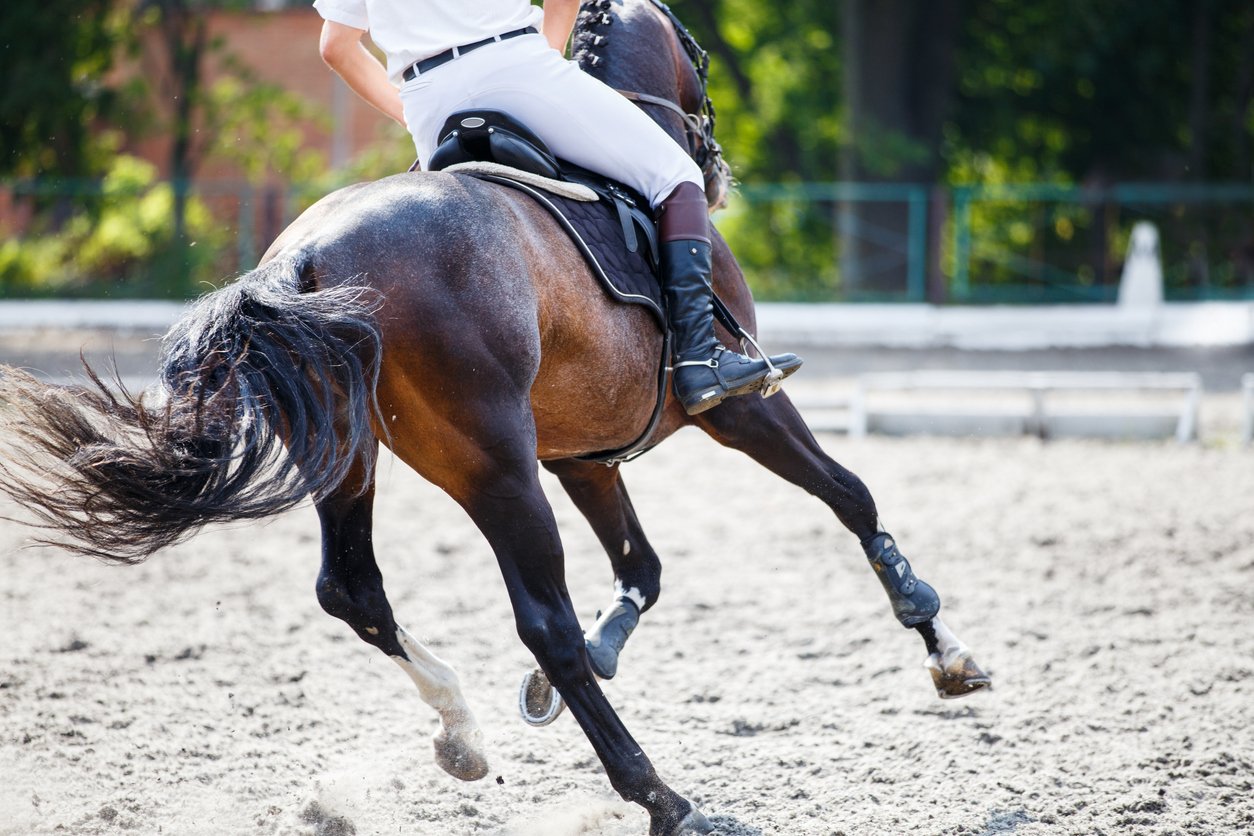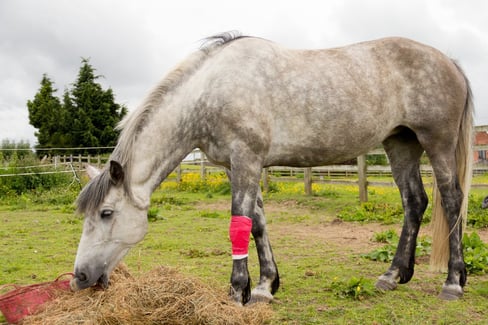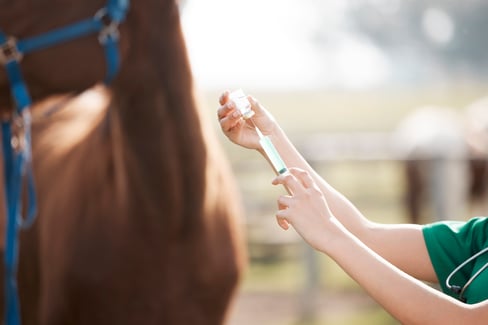Table of Contents
Horses are natural-born athletes. 🐎🏇
It doesn’t matter if they’re world-class racehorses or simply experienced schoolmasters.
And this incredible athleticism is what makes proper horse training critical for maintaining a healthy, happy equine partner.
But you surely know all about that, so rather than focusing our efforts on horse training itself, we’ll take a slightly different spin on the subject.
We’ll put our experience in joint health and horse arthritis supplements into action and discuss how to keep your horse’s musculoskeletal system in optimal shape during training and competitions.
We’ll cover:
- The anatomy and importance of equine articulations
- The major joint diseases that can afflict your horse
- The benefits of using premium glucosamine-based supplements
- Common horse training and supplementation FAQs
All of this handy information will help you catch potential problems before they degenerate, saving your horse from unnecessary pain and you from costly vet bills.
Ready to jump in?
Fantastic, us too — it’s going to be a fun hack!
Horse Joints: The Basics Every Owner Needs To Know
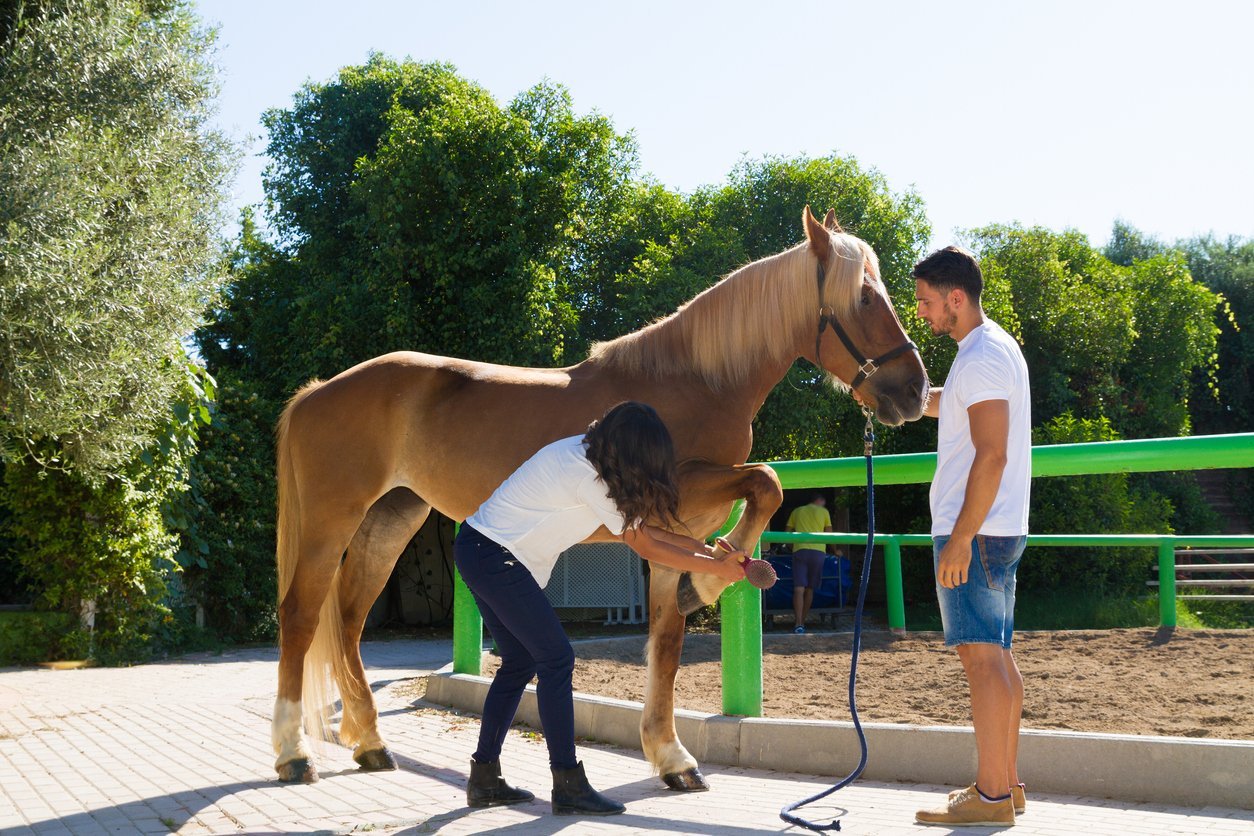
A great place to start our journey is with a crash course on joint anatomy.
We’ll only spend a couple of minutes here, so make sure to pay close attention and memorize the structure and function of horse joints.
If you’re already well-versed in this area, feel free to skip to the next section. But if you have even the slightest of doubt, a bit of revision won’t hurt.
So what are horse joints?
Joints (or articulations) are highly specialized junctions within the musculoskeletal system that form where two or more bones meet. They are considered organs.
There are three types of joints in a horse’s body: fibrous, cartilaginous, and synovial. This last one is the most important of the three, and its primary function is to enable movement and load transfer between bones. Absolutely pivotal stuff!
A horse has 18 synovial joints, including the shoulder, elbow, stifle, knee, and hock. There are three types of these joints (ball and socket, hinge, gliding), and they all share the same basic structure:
- Two (or more) bones
- A thin layer of articular cartilage
- A synovial cavity between the bones filled with synovial fluid
- A synovial membrane lining the inner joint
- A joint/articular capsule enclosing the joint
- Ligaments and tendons for stabilization and movement
This excellent infographic from theHorse.com sums it up perfectly:
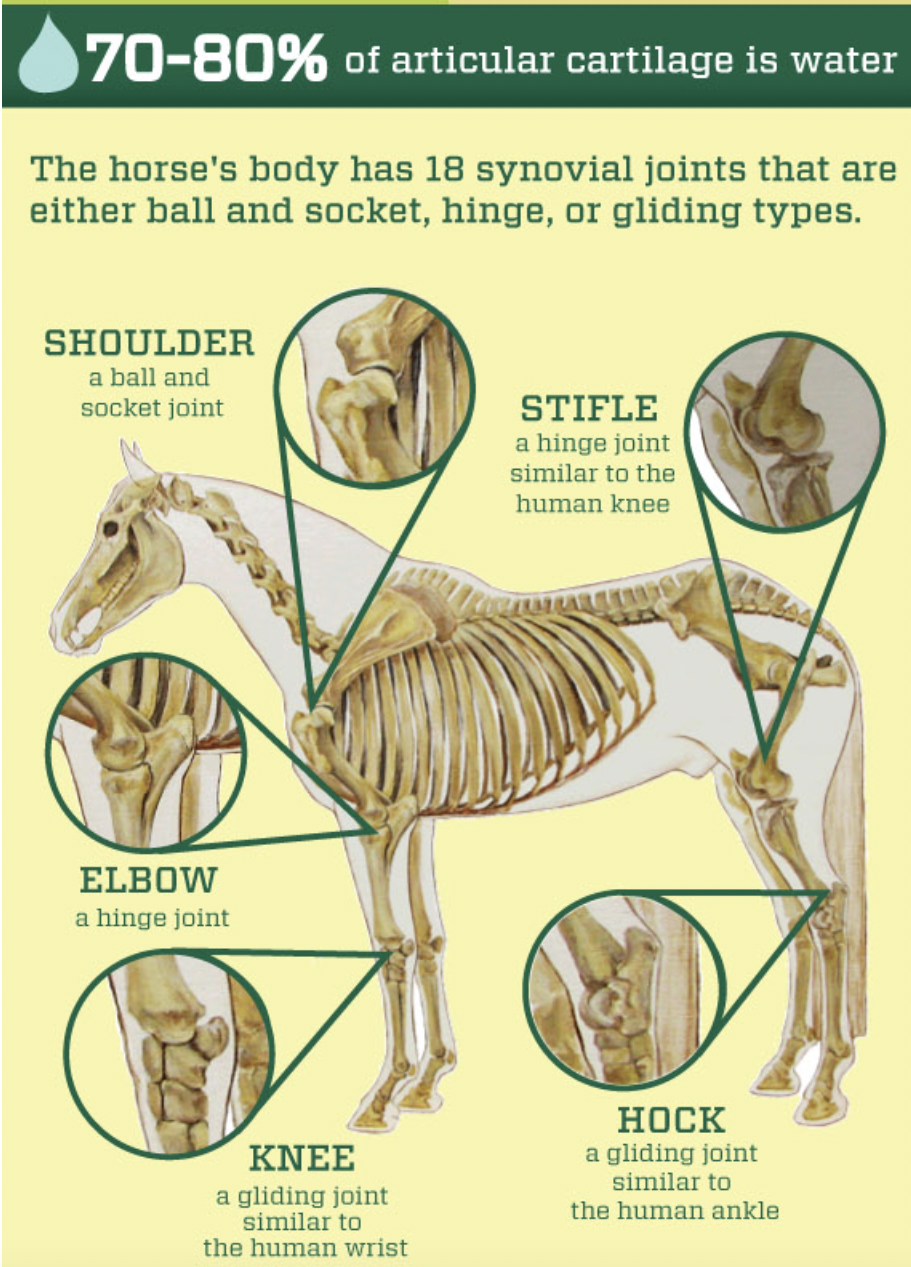
And that’s it — you’re ready to deep dive into joints, so let’s go!
Why Are Healthy Joints an Important Part of Horse Health?
If we had to summarize it in just a couple of sentences, our answer would be:
Healthy, functional joints allow your horse to be a horse. And if they become damaged in any way, your horse will struggle to engage even in the most basic equine activities.
You can forget all about eventing when your partner struggles to walk and graze!
But since we have a bit more time, here’s a little table with a more in-depth answer:
| Reason why | Details |
| Active lifestyle | Your horse needs their joints to live an active, happy life. Being able to move pain-free allows them to engage in essential activities like grazing, playing, rolling, and socializing. |
| Athletic performance | We mentioned that all horses are athletes. And what kind of athlete is happy without training and competing at the very top of their game? None, we checked.
This point is even more important for sports horses as their entire way of life depends on solid joints. A problem could mean the end of their careers. |
| Lower risk of injuries | Unfortunately, injuries are a part of life. The best you can do is reduce the risk by taking preventative actions like secure fencing, even grounding, and supplementation.
But there’s nothing better than a healthy musculoskeletal system for withstanding the accidental slip, pull, or kick. |
| Stronger muscles | Horses have some serious muscles. They make bodybuilders jealous!
But without healthy joints and proper exercise, their muscles can face stiffness, weakness, and atrophy. |
| Avoidance of chronic diseases | Last but not least, healthy joints mean your horse doesn’t have to suffer through painful, degenerative conditions like arthritis. |
However, no matter how hard you work to keep their joints healthy, sometimes things go wrong…
And you need to be prepared because you have to be able to identify any issue early on and get your horse’s treatment pronto.
An attentive owner is often the difference between a horse making a speedy recovery or developing a chronic condition. So, what equine health problems should you be able to recognize?
These seven ones:
Joint Ailments/Diseases in Horses & Impact on Overall Health
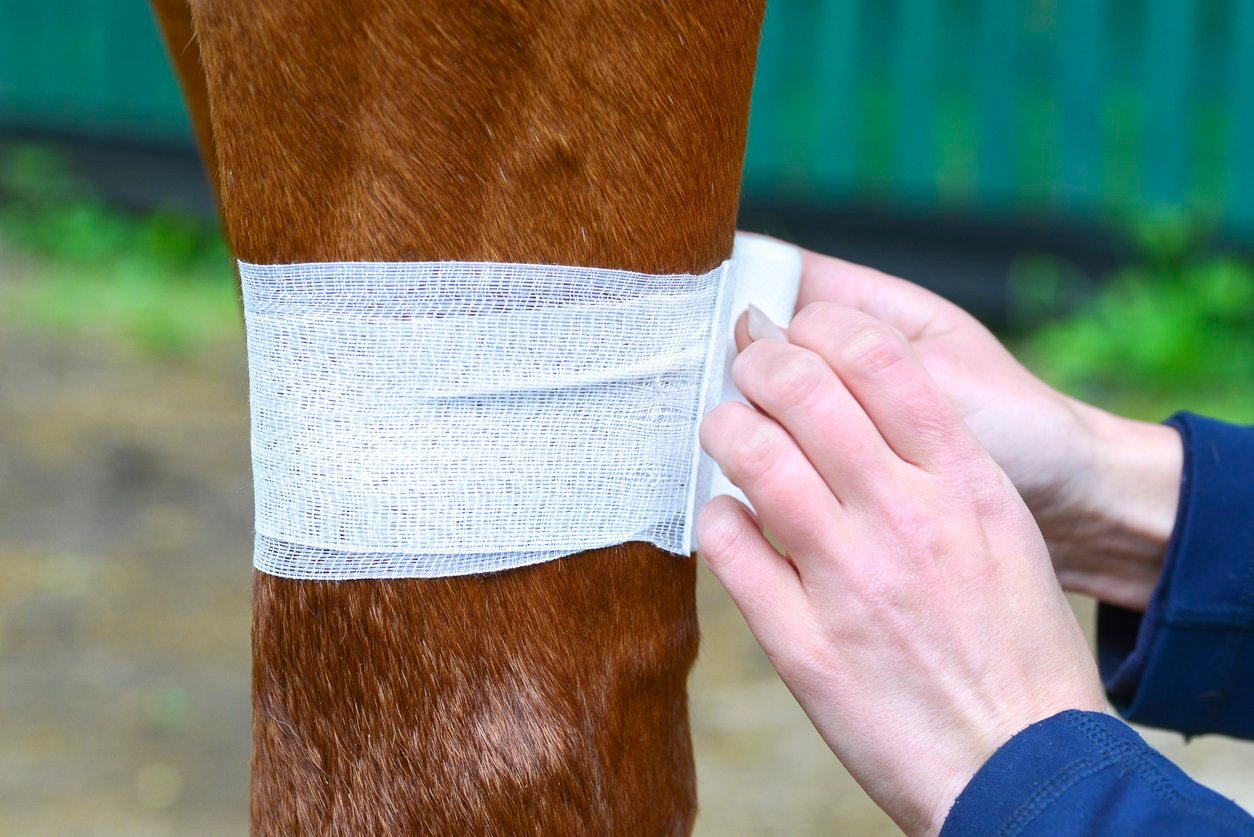
1. Arthritis
Every single horseman and horsewoman in the world needs to be aware of arthritis.
It’s the leading cause of equine lameness and loss of function — some surveys even estimate that it’s behind a whopping 60% of cases!
These numbers just made the hair on the back of my neck stand up…
Please tell me more.
Arthritis is the name used to describe several types of prolonged inflammation in a joint that are often accompanied by pain, stiffness, and limited movement.
These include:
- Traumatic arthritis – caused by an injury
- Osteochondritis – caused by joint cartilage separating from the bone
- Septic arthritis – caused by an infection
- Osteoarthritis (OA) – caused by the progressive deterioration of the joint cartilage due to old age and overexertion
OA is the most common form of the disease, and the terms arthritis and OA are frequently used as synonyms.
Many owners associate this condition with older horses (typically over 15) and don’t worry about it until it shows its ugly face…
But, by that point, it’s far too late because OA can’t be cured or reversed.
Arthritis has to be proactively and preventively managed to delay its onset and limit pain/swelling in your horse’s joints.
Symptoms of Arthritis
- Morning stiffness
- Pain, stiffness, and swelling of one or more joints
- Difficulties moving or exercising
- Poor mood / behavioural changes
- Strange or awkward gaits and stances
If you notice any of these warning bells, call your equine vet immediately and get an early diagnosis.
2. Bursitis
There’s one small part of the joint we didn’t mention in our anatomical discussion.
The bursa — a small sac filled with fluid that sits between a bone and a tendon.
And while you don’t need to know about its precise nature, location, and function (unless you want to become a vet or a true expert), you need to know about bursitis.
It’s the inflammation of the bursae, usually caused by trauma, overexertion, and/or bacterial infection.
It can be classified as either true bursitis when a natural bursa becomes inflamed, or acquired bursitis, when a bursa develops in a place where it didn’t previously exist.
And it can cause pain and lameness if left undetected.
So how do you identify it?
Symptoms of Bursitis
- Visible swelling around one of the joints
- Localized heat
- Limping or lameness
- Pain or tenderness to the touch
If you pick up on any of these signs, contact your veterinarian and ask them to examine your horse and make a definitive diagnosis.
3. Laminitis
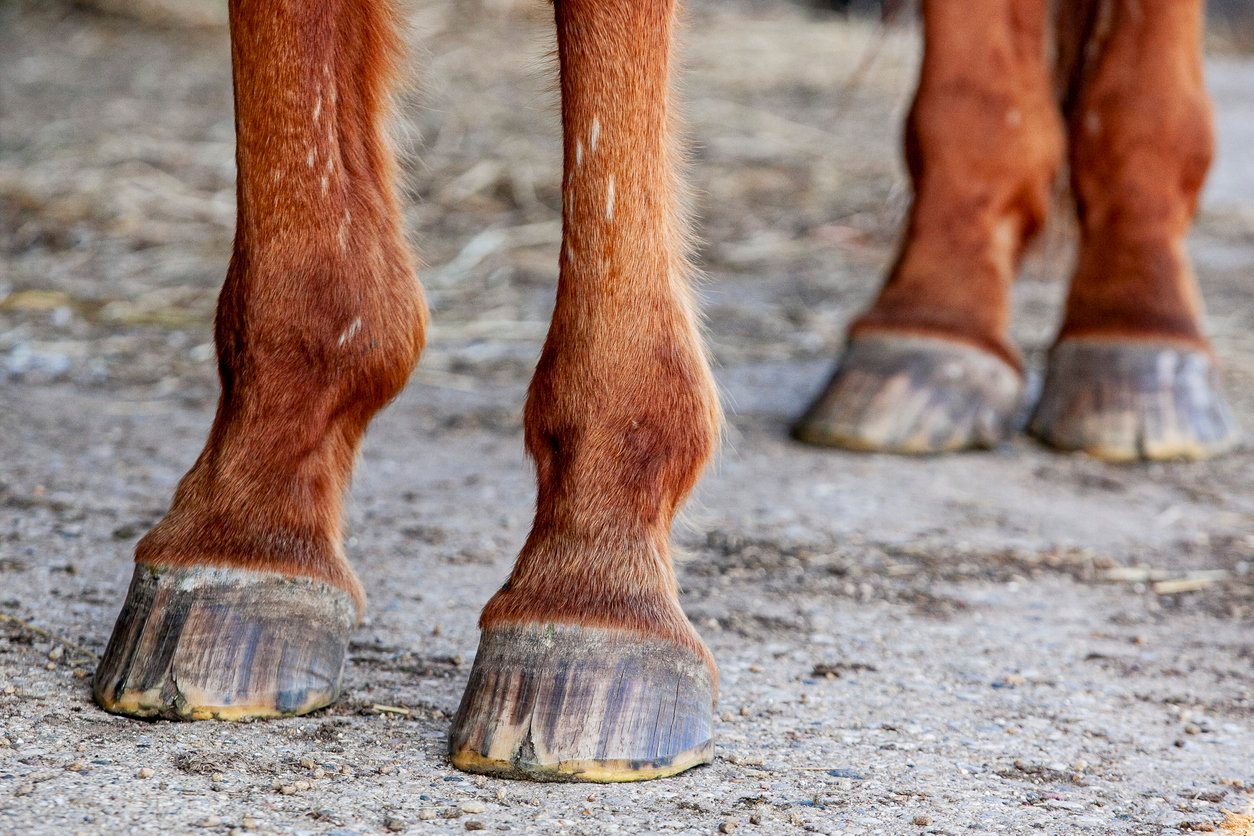
Next up, it’s another -itis… and more precisely, laminitis.
It’s one of the most painful and dangerous diseases our equine friends can suffer through.
And it’s potentially fatal if its symptoms get out of hand.
Even horseracing legend Secretariat succumbed to its complications.
What is it exactly?
Laminitis is an excruciating inflammation of the laminae (soft tissues) that connect the pedal bone to the hoof wall.
When these tissues become inflamed, they don’t receive adequate amounts of blood and oxygen, and their cells start to die.
If left unchecked for long enough, the laminae lose their ability to support the pedal bone, and this bone begins to spin and sink downwards. In severe cases, it can even penetrate the sole and visibly stick out.
Ouch!
This means you have to be religious in watching out for laminitis and rush to the vet like never before if you suspect this condition.
Symptoms of Laminitis
- The hoof is warm to the touch
- Unusual stances (i.e., the ‘rocked back’ pose)
- Lameness or hesitant gaits
- Frequent lying down or reluctance to move
- A rapid digital pulse
- Divergent hoof rings or a slipper-shaped hoof wall
4. Locked Stifle Joints
You’ve already learned that a stifle is a synovial joint that’s similar to the human knee.
It’s a locking hinge that helps horses balance when moving, standing, or taking a nap.
It’s usually completely effortless for a horse to lock and unlock their stifles. However, sometimes they get stuck in the locked position.
And when this happens, your equine partner will feel stiffness and discomfort in their joints as well as struggling to move properly.
Treatment is necessary, but there’s some good news:
The majority of horses make a full recovery.
Symptoms of Locked Stifle Joints
- Minor signs of lameness
- Sluggishness or hesitancy when they start moving after a period of standing still
- Stumbling when going downhill
- Difficulties cantering or executing lead changes
- Trouble with circle work
5. Desmitis
Desmitis is another leading cause of lameness in sport and working horses.
Their extra workload is the culprit.
Over-training and overexerting our equine athletes comes with the hefty price tag of inflamed ligaments or, in other words, desmitis.
There are three major types of this disorder:
- Degenerative Suspensory Desmitis
- Proximal Suspensory Desmitis
- Degenerative Suspensory Ligament Desmitis
The trickiest thing about inflamed ligaments is that they aren’t easy to spot until after they’ve developed into a serious problem.
Thus, you must take strict care to prevent the issue and diagnose it early on with the help of your veterinarian.
If your horse develops this condition, they’ll require long periods of rest (several months to a year) to recover fully.
Symptoms of Desmitis (N.B. not always visible)
- Various degrees of lameness
- Changes in your horse’s gait
- Reduced performance
- Swelling and/or heat in the affected area
6. Tendon Injuries and Inflammations

Ligaments aren’t the only tissues to suffer from overexertion…
Tendons are also at the receiving end of a vigorous horse training routine.
Despite being very elastic, these connective bands (that connect muscles to bones) can strain or tear if pushed to the limit too hard or too often.
When this happens, you could be looking at a problem ranging anywhere from minor inflammation to a career-ending injury that needs surgery — yikes!
Prevention is the best strategy for avoiding tendon issues. Try out training tactics like:
- Steering clear of repetitive actions
- Thoroughly warming up and cooling down
- Investing in high-quality horseshoes
- Engaging in progressive overload
Whatever you do, the key is to NOT put too much pressure too quickly on your horse.
Symptoms of Tendon Injuries and Inflammations
- Unusual gaits (i.e., walking with their toes up)
- Swelling
- Reduced performance
- Visible signs of pain
- Unwillingness to train or do certain exercises
7. Back Injuries
A horse’s back is an incredibly complex part of their bodies.
Just have a look at this diagram from veteriankey.com:
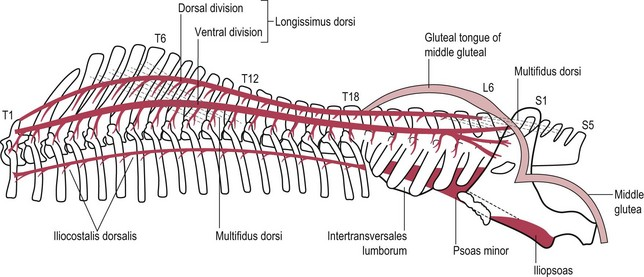
Awe-inspiring, right?
You betcha.
But with all those vertebrae come back issues (you know the feeling, we humans also have to endure this type of pain).
One of the most common equine back problems is called ’kissing spine’ — it affects nearly 40% of horses.
It occurs when the vertebrae lie too close to one another and rub together when the horse moves. This can be a source of pain, especially when combined with a saddle that fits poorly or other musculoskeletal disorders.
Back pain is generally easy to identify because it triggers explosive reactions and strange behaviours. If your horse answers ‘no’ to your commands and shows signs of discomfort, call the vet and discuss the possibility of a back issue.
Symptoms of Back Injuries
- Overt displays of pain
- Uncooperative behaviour during a saddle fitting
- Averseness to follow commands and exercise
- Anxiety
How Can Horse Supplements Maintain Optimal Joint Health?
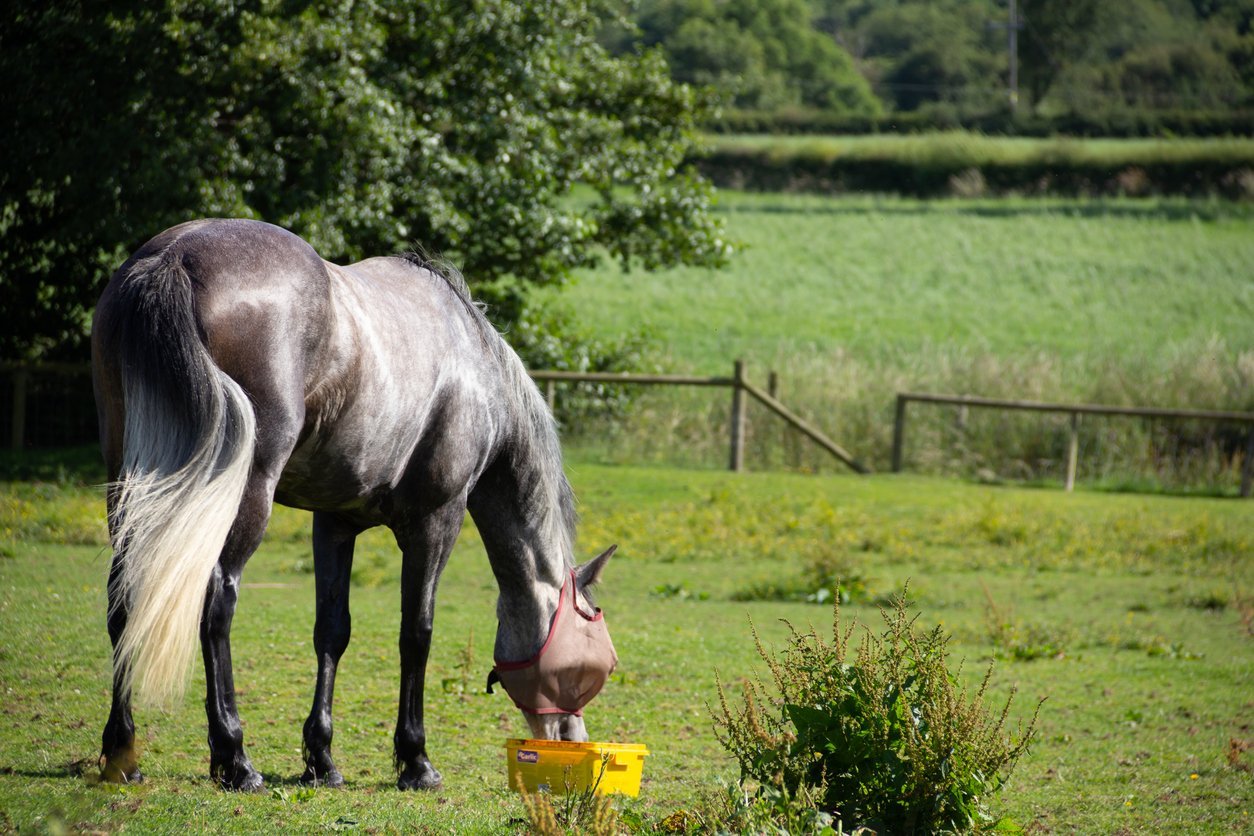
These ailments all sound pretty serious, and that’s because they are.
You definitely want to keep them as far away from your equine buddy as humanly possible.
Two of the best actions you can take are:
- Feed your horses a healthy diet.
- Use premium supplements to provide an extra boost of essential ingredients.
And when it comes to joint health, there are four active ingredients to look out for: glucosamine, chondroitin sulfate, methylsulfonylmethane (MSM), and hyaluronic acid (HA).
They have four key benefits on joint health.
Let’s cover them one by one.
But first, write these long names down as there’s no way you’ll remember them tomorrow!
Benefit 1: Joint Supplements Support Your Horse’s Cartilage
Your horse’s body naturally produces and repairs the cartilage in their joints.
However, over time, their ability to create enough cartilage on their own starts to wane.
And when you combine that with an active lifestyle and maybe even a high-stakes sports career, your horse’s joints are in trouble.
This is where a quality supplement with glucosamine and chondroitin sulfate steps in.
Glucosamine is a naturally occurring amino sugar that’s a fundamental building block for creating cartilage and synovial fluid. Its presence in supplements helps your horse repair their cartilage by encouraging the production of glycosaminoglycans and proteoglycans.
It’s ideal when two types of glucosamine (sulfate and hydrochloride) are added to supplements as this improves bioavailability (how easy it is to absorb the nutrient) and effectiveness.
Chondroitin, on the other hand, has a slightly different job. Its main roles are to:
- Sweep nutrients into your animal’s cartilage and maximize glucosamine’s positive effects.
- Prevent cartilage breakdown by neutralizing destructive enzymes in the joints.
All of these benefits mean one thing:
By supplying both glucosamine and chondroitin to your horse, you’re doing them a real service.
Benefit 2: Joint Supplements Reduce Pain and Inflammation
Alongside stimulating the reparation and regeneration of cartilage, a good supplement should also help you manage pain and inflammation.
This is primarily achieved through the use of an organosulfur compound named methylsulfonylmethane (MSM).
This dietary supplement delivers a good dose of sulfur, an essential nutrient for absorbing vitamins and amino acids, to your horse’s body and joints. There, it’s used to form a strong collagen matrix that improves mobility and reduces inflammation, swelling, and pain.
And when you fuse this effect with the long-term healing effects of glucosamine and chondroitin, you get the best of both worlds, a.k.a. an excellent mix of joint healing substances.
Benefit 3: Supplements Keep Joints Flexible and Well-Lubricated
Remember that back in the first section you learned that joints have a synovial cavity? And that’s it filled with a liquid called synovial fluid?
Great memory! 🙌
Well, this fluid is crucial because it increases a joint’s flexibility, strength, and ability to absorb shocks pain-free.
Pretty cool, don’t you think?
However, an aging or injured body struggles to produce enough fluid and joints are at risk of losing too much moisture. This can reduce all the positive effects we just mentioned.
But here comes hyaluronic acid (H.A.) to the rescue!
H.A. is another naturally occurring substance found in various parts of the body. And supplementing your horse’s diet with it increases both the amount and the viscosity of synovial fluid available in their joints.
This, in turn, helps to return their joints to their former glory, especially if combined with the three musketeers: glucosamine, chondroitin, and MSM.
Benefit 4: Joint Supplements Help Keep Arthritis at Bay
When you put together the ingredients behind the three benefits we’ve gone through in this section, you get the perfect cocktail for horse arthritis supplements!
A pharmaceutical-grade dose of glucosamine, chondroitin, MSM, and H.A. is a gamechanger.
It’ll help delay the onset of arthritis (if used preventively) and/or minimize its symptoms by:
- Encouraging cartilage and synovial fluid production
- Inhibiting harmful enzymes
- Reducing pain and stiffness
In short, a premium joint supplement like our own TRI-ACTA H.A. gives your horse a great shot at staying limber and mobile well into their later years!
FAQs About Using Horse Supplements During Horse Training
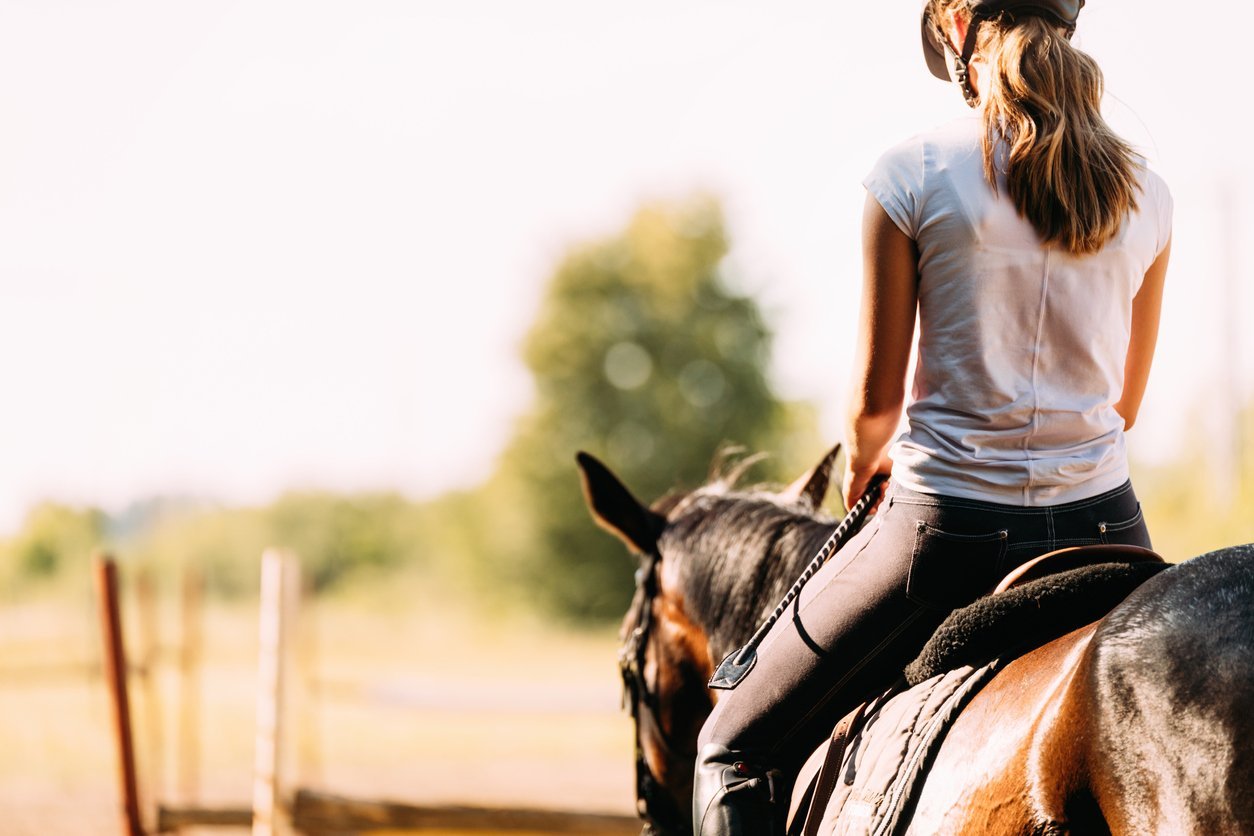
“Which Supplements Do You Feed Your Horse?”
There’s a wealth of horse supplements available for your partner.
Some of the options include:
- Joint & horse arthritis supplements
- Vitamins & minerals
- Hoof care supplements
- Weight gain supplements
- Skin & coat supplements
- Gastric & digestive support supplements
- Calming supplements
Speak to your veterinarian or check out this guide from Equus Magazine if you need some help picking out the right ones.
“How Do You Get a Horse To Eat Supplements?”
So you’re wondering how to get a horse to eat supplements… we’ve all been there!
Horses are creatures of habit with a keen sense of smell, and that means that sometimes they won’t like it when you add a new supplement to their hard feed.
But not to worry, these two tricks should do the job:
- Start with a small amount of supplements and slowly and steadily increase it until you’ve reached the full dose — the gradual change should be undetectable.
- Mask the supplement’s smell and taste by mixing it with a delicious treat like apples, carrots, or molasses and oats.
“And What About How To Get a Horse To Eat Powdered Supplements?”
Powders are the easiest supplements to feed your horse, especially if they have small, concentrated doses (like our TRI-ACTA products).
You should simply add the powder to their feed and, if you have any problems, try the two tricks mentioned in the previous question.
It’s also a good idea to soak their feed with some water to ensure the powder supplement sticks to the hard feed and gets eaten.
“What Are the Best Horse Training Methods?”
There are dozens of horse training methods, and there’s no best one.
It all depends on the trainer and the horse.
Generally speaking, we can split horse training methods into five categories:
-
- Traditional horse breaking – punishment-based
- Science-based training – reward-based, i.e., Clicker Training
- Natural horsemanship – horse behaviour-based, i.e., Parelli
- Classical horsemanship – based on the grandmasters, i.e., the School of Légèreté
- Balanced training – a mixture of various schools and methods
Each method comes with its own advantages and disadvantages.
We suggest you speak with various trainers and get plenty of varied experience before settling on the one that works best for you and your horses.
Summary: Maintaining Joint Health During Horse Training
Mastering equine joint health is a fundamental part of every horse owner’s job description.
So pat yourself on the back for making it through this detailed article on the subject…
You deserve it — you’ve just gained a ton of valuable knowledge!
To make sure the information sticks, here’s a quick summary of everything you’ve learned:
- The anatomy of equine joints and why they’re important
- Seven painful ailments that affect horses’ musculoskeletal systems (arthritis, bursitis, laminitis, locked stifle joints, desmitis, tendon injuries, back injuries)
- Four ways glucosamine-based supplements support optimal joint health
- The answers to four FAQs about using supplements during horse training
And speaking of joint supplements, we would be happier than this contagiously cheerful horse if you gave our Equine TRI-ACTA products a try.
We guarantee you won’t be disappointed.
Not sure which of our two supplements to pick? Use this table for guidance.
| Product | Indicated For |
| Equine TRI-ACTA | Preventative support for younger horses |
| Equine TRI-ACTA H.A | Senior horses, Sport or working horses, or horses with pre-existing conditions |
And as always, send us a quick note if you have any questions, and thank you for reading!
Newsletter Signup
Subscribe to our newsletter to receive the latest news and exclusive offers.
.jpg?height=2000&name=Cliick_Integricare-DISPLAY-REVISEDV2%20(1).jpg)
Proactive & Therapeutic Joint Supplements
When given daily, Integricare joint supplements recover bone and joint injuries faster and help prevent mobility injuries from happening in the first place.

